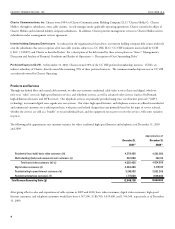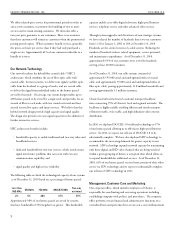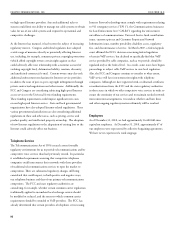Charter 2010 Annual Report Download - page 23
Download and view the complete annual report
Please find page 23 of the 2010 Charter annual report below. You can navigate through the pages in the report by either clicking on the pages listed below, or by using the keyword search tool below to find specific information within the annual report.
0
Our key competitors include:
DBS
Direct broadcast satellite is a significant competitor to cable systems.
e two largest DBS providers now serve more than 33 million
subscribers nationwide. DBS service allows the subscriber to receive
video services directly via satellite using a dish antenna.
Video compression technology and high powered satellites allow
DBS providers to offer more than 280 digital channels from a single
satellite, thereby surpassing the traditional analog cable system. In
2010, major DBS competitors offered a greater variety of channel
packages, and were especially competitive with promotional pricing
for more basic services. While we continue to believe that the initial
investment by a DBS customer exceeds that of a cable customer, the
initial equipment cost for DBS has decreased substantially, as the
DBS providers have aggressively marketed offers to new customers
of incentives for discounted or free equipment, installation, and
multiple units. DBS providers are able to offer service nationwide
and are able to establish a national image and branding with
standardized offerings, which together with their ability to avoid
franchise fees of up to 5% of revenues and property tax, leads to
greater efficiencies and lower costs in the lower tiers of service.
Also, DBS providers are currently offering more high definition
programming, including local high definition programming.
However, we believe that cable-delivered OnDemand and
Subscription OnDemand services, which include HD programming,
are superior to DBS service, because cable headends can provide
two-way communication to deliver many titles which customers
can access and control independently, whereas DBS technology can
only make available a much smaller number of titles with DVR-like
customer control. DBS providers have also made attempts at
deployment of high-speed Internet access services via satellite, but
those services have been technically constrained and of limited appeal.
Telephone Companies and Utilities
Our telephone service competes directly with established telephone
companies and other carriers, including Internet-based VoIP
providers, for voice service customers. Because we offer voice
services, we are subject to considerable competition from telephone
companies and other telecommunications providers, including
wireless providers with an increasing number of consumers choosing
wireless over wired telephone services. e telecommunications
and competitive voice services industry is highly competitive and
includes competitors with greater financial and personnel resources,
strong brand name recognition, and long-standing relationships
with regulatory authorities and customers. Moreover, mergers,
joint ventures and alliances among our competitors have resulted in
providers capable of offering cable television, Internet, and telephone
services in direct competition with us.
Most telephone companies, which already have plant, an existing
customer base, and other operational functions in place (such as
billing and service personnel), offer DSL service. DSL service allows
Internet access to subscribers at data transmission speeds greater
than those available over conventional telephone lines. We believe
DSL service is competitive with high-speed Internet service and is
often offered at prices lower than our Internet services, although
typically at speeds lower than the speeds we offer. However, DSL
providers may currently be in a better position to offer data services
to businesses since their networks tend to be more complete in
commercial areas. We expect DSL to remain a significant competitor
to our high-speed Internet services. In addition, the continuing
deployment of fiber optics into telephone companies’ networks
(primarily by Verizon Communications, Inc. (“Verizon”)) will enable
them to provide even higher bandwidth Internet services.
Telephone companies, including AT&T Inc. (“AT&T”) and Verizon,
offer video and other services in competition with us, and we expect
they will increasingly do so in the future. Upgraded portions of
these networks carry two-way video, data services and provide digital
voice services similar to ours. In the case of Verizon, high-speed data
services (fiber optic service (“FiOS”)) offer speeds as high as or higher
than ours. In addition, these companies continue to offer their
traditional telephone services, as well as service bundles that include
wireless voice services provided by affiliated companies. Based on
internal estimates, we believe that AT&T and Verizon are offering
video services in areas serving approximately 24% to 29% and 3%
respectively, of our estimated homes passed as of December 31, 2010
and we have experienced customer losses in these areas. AT&T
and Verizon have also launched campaigns to capture more of the
multiple dwelling unit (“MDU”) market. Additional upgrades and
product launches are expected in markets in which we operate.
In addition to telephone companies obtaining franchises or
alternative authorizations in some areas, and seeking them in others,
they have been successful through various means in reducing or
streamlining the franchising requirements applicable to them. ey
























